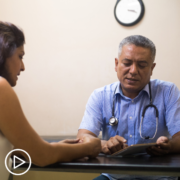Understanding Myeloma Therapy Targets BCMA and GPRC5D
Understanding Myeloma Therapy Targets BCMA and GPRC5D from Patient Empowerment Network on Vimeo.
What are myeloma targets, and how do they impact the effectiveness of therapy? Dr. Krina Patel explains how treatments like bispecific antibodies and CAR T-cell therapy are using myeloma targets such as BCMA (B-cell maturation antigen) and GPRC5D (G protein-coupled receptor 5D) to kill myeloma cells.
Dr. Krina Patel is an Associate Professor in the Department of Lymphoma/Myeloma at The University of Texas MD Anderson Cancer Center in Houston, Texas. Dr. Patel is involved in research and cares for patients with multiple myeloma.
Related Resources:

Will CAR T-Cell Therapy Be Approved for Earlier Lines of Myeloma Treatment? |

|

How Can Myeloma Patients Access CAR T-Cell Therapy Clinical Trials? |
Transcript:
Katherine:
We know that the currently approved bispecific antibody therapies target BCMA and GPRC5D. What are these targets precisely and how do they impact the effectiveness of the treatment?
Dr. Krina Patel:
No, it’s a great question.
And, again, so BCMA we’ve had for a little bit longer.
We’ve known about it for a little bit longer, B cell maturation antigen, which definitely we’ve used as much as we can. So, we’ve had CAR Ts for it. We’ve had bispecifics for it. We’ve had antibody drug conjugates that we’ve attached to it.
So, it’s a really good target that is mostly just on myeloma cells and on very few other cells in the body, for the most part, which is why it makes such a great target. The side effects really should happen only specifically against the myeloma; so, less side effects in terms of toxicity. That’s not 100 percent the case.
BCMA is in some other tissues, like maybe the nerves, and that’s why maybe we see this toxicity sometimes, potentially in the GI system. Some patients can have it in other places. If you have myeloma in, let’s say, areas like the kidney. If you have a plasmacytoma, it can go to the kidney, things like that.
But again, for the most part, mostly on myeloma. And what’s really important about these targets is, once you get a treatment for it, what happens to that target. So, that’s a little bit different between these two targets. So, BCMA is a part of the proliferation of myeloma cells. So, it actually helps the myeloma cell survive. And so, the myeloma cells really want that BCMA on there. Now, for CAR T, for the most part, we don’t see people losing BCMA. We might see it go down in the myeloma cells that are left. For some patients, the expression can go down. But for the most part, we’ll see it come back up a few months later if the myeloma’s coming back.
The way that resistance happens with BCMA is that, when people are on bispecifics, the other treatment, we can sometimes see the BCMA get mutated. And then, maybe the other therapies we have won’t go after it any more.
So, again, it’s not common, but that’s sorta something we look at when we talk about sequencing therapy or which therapy should we use first. Then, GPRC5D’s a little different.
So, again, mostly just on myeloma cells. But here, we do know it’s on something called epithelial cells, which is skin, nails, tongue. And that’s why some of the side effects that we see, especially with the bispecific that’s a standard of care already, talquetamab, is skin and nail changes. So, people can get sloughing of their hands and nails; that can get disrupted. And then, taste. People can actually have some significant taste loss, to the point that they can have weight loss from it.
So, this is why that part is so important that if we have patients with these side effects, we need to hold the drug or decrease it; so, make sure we can turn those around. And then, the way GPRC5D is we think that it’s a little bit more likely that you can lose it once you get a treatment with GPRC5D that the myeloma can actually learn how to shed the antigen.
So, again, this really becomes important when we talk about combination and sequencing of all these different therapies we have and what’s the best way to do it so that patients can have the best response and the longest response.



















